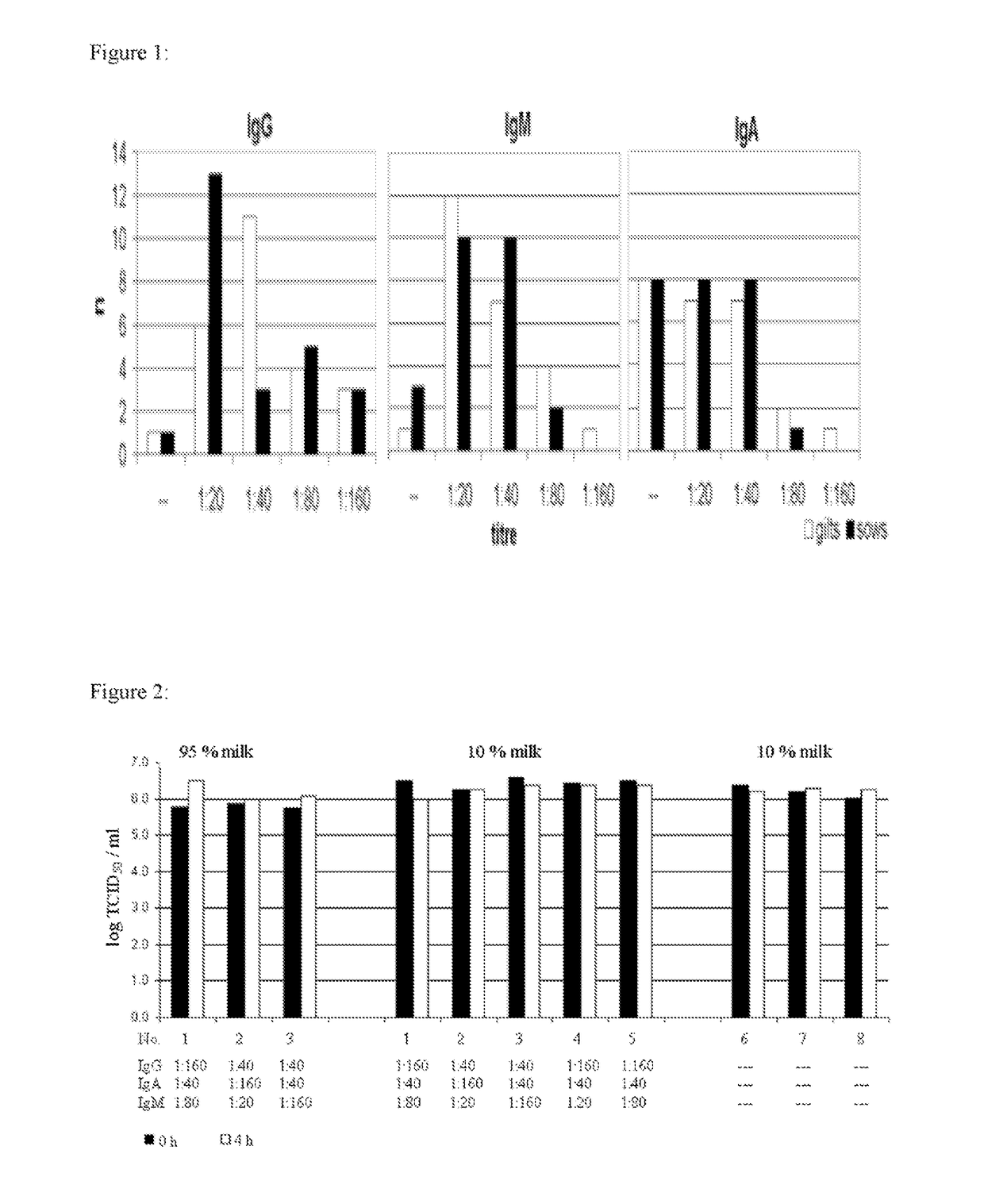Vaccination of young animals against Lawsonia intracellularis infections
a technology of lawsonia intracellularis and vaccines, applied in the field of vaccines of young animals against i>lawsonia intracellularis /i>infections, can solve the problems of not preventing the establishment of active protection against i>l. intracellularis , maternal antibodies and sow milk do not appear effective for inactivation. i>l. intracellularis , the
- Summary
- Abstract
- Description
- Claims
- Application Information
AI Technical Summary
Benefits of technology
Problems solved by technology
Method used
Image
Examples
example 1
Detection of Antibodies Specific to L. intracellularis in Colostrum and Milk Samples from Sows (>1 Litter) and Gilts (1st Litter)
Material and Methods
[0063]Colostrum samples were taken from 25 sows and 25 gilts within 24 hours after farrowing. Milk samples were taken in the first and second week of lactation from the same pigs. Samples were centrifuged twice with 200 g for 10 minutes at 4° C. to separate the fatty portion of the milk. The watery portion of the samples was stored at −20° C. until analysis. Specific antibodies against L. intracellularis were detected in serial 2 fold dilutions starting with an initial dilution of 1:20 in an IFAT. The IFAT was performed as described in Example 5 and elsewhere, with the exception that for each sample, FITC-labelled anti-swine IgG, IgM, and IgA antibodies were used to detect the different classes of Ig. Parallel blood samples from the sows and gilts were taken with 24 hours after farrowing. These samples were examined in the Enterisol® Il...
example 2
Direct Impact of Milk Antibodies on L. intracellularis During Gastro-intestinal Passage
Material and Methods
[0070]Colostrum samples were taken from sows and gilts within 24 hours after birth. Sow milk samples were taken in the first and second week of lactation. Samples were centrifuged twice with 2000 g for 10 minutes at 4° C. to separate the fatty portion of the milk. The watery portion of the samples was stored at −20° C. until analysis. Specific antibodies against L. intracellularis were detected in serial 2 fold dilutions starting with an initial dilution of 1:20 in an IFAT. The IFAT was performed as described in Example 5 and elsewhere (5), with the exception that for each sample, FITC-labelled anti-swine IgG, IgM and IgA, antibodies were used to detect the different classes of Ig. Milk samples with different content of Ig were selected on basis of IFAT results. A L. intracellularis culture was incubated with different dilutions in colostrum or sow milk samples at room temperat...
example 3
Efficacy of Vaccination of Piglets of One Day of Age Against L. intracellularis Infections
Materials and Methods
[0079]The study consisted of three experimental groups involving L. intracellularis negative and anti-Lawsonia maternal antibody negative suckling piglets at 1 day of age. On day 0 of the study, 20 piglets each in group 1 (vaccinates) received an oral dose of Enterisol® Ileitis, vaccine isolate B3903, per label instructions (3). Twenty piglets in group 2 (controls) received a placebo consisting of growth medium. Piglets in all groups were weaned on day 20 of the study. On day 21, piglets in groups 1 and 2 received an intestinal homogenate containing 3.5×109 of virulent L. intracellularis 2688 / 2685 via gavage. A third group of 10 pigs (strict controls) did not receive vaccine, placebo or challenge at any time period throughout the study. On day 42, pigs in all groups were humanely euthanized and necropsied. Primary efficacy parameters included gross and microscopic lesions o...
PUM
| Property | Measurement | Unit |
|---|---|---|
| initial weights | aaaaa | aaaaa |
| initial weights | aaaaa | aaaaa |
| initial weights | aaaaa | aaaaa |
Abstract
Description
Claims
Application Information
 Login to View More
Login to View More - R&D
- Intellectual Property
- Life Sciences
- Materials
- Tech Scout
- Unparalleled Data Quality
- Higher Quality Content
- 60% Fewer Hallucinations
Browse by: Latest US Patents, China's latest patents, Technical Efficacy Thesaurus, Application Domain, Technology Topic, Popular Technical Reports.
© 2025 PatSnap. All rights reserved.Legal|Privacy policy|Modern Slavery Act Transparency Statement|Sitemap|About US| Contact US: help@patsnap.com

